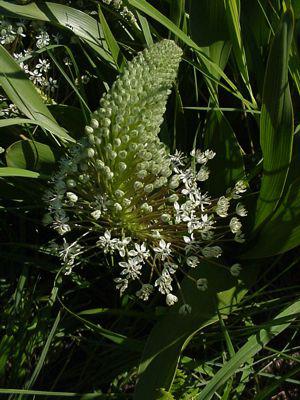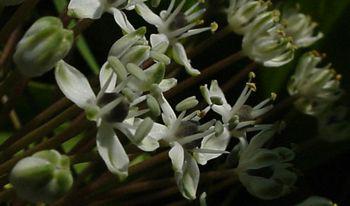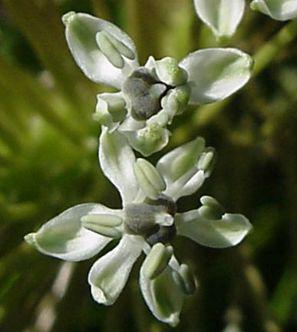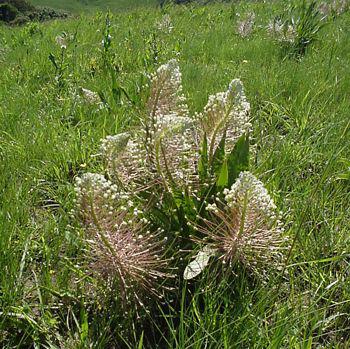Schizocarphus nervosus
Schizocarphus nervosus (Burch.) Van der Merwe ( = Scilla nervosa (Burch.) Jessop)
Family: Hyacinthaceae
Common names: white scilla, white wild squill (Eng.); sandlelie (Afr.); seboka (Sesotho); imbita-yebantwana, ndvwendvweni (siSwati); sabantwana, umagaqana, inkwitelu, (Xhosa); ingcino, ingcolo, umgcinywana, imbizankulu ingema (Zulu)
Introduction
White scilla is a bulb used medicinally for various ailments. It is easily propagated from bulbs, forms clumps and is a drought-resistance species.

Description
Description
Schizocarphus nervosus is a small geophyte, growing up to 400 mm high and forming rounded clumps. Its underground bulb is ± 100 mm in diameter and covered with coarse bulb scales. The leaves are erect, leathery, bright green, seldom twisted and appear at the same time as the flowers. This is a summer growing species.

The flowering stem is erect or lax, with a spike of white or creamy yellow flowers. Schizocarphus nervosus flowers from September to February.

It is sometimes known by the following synonyms: Ornithogalum nervosum, Scilla nervosa, S. rigidifolia, S. gerrardii and S. acerosus.

Conservation Status
Status
According to Raimondo et al. (2009), Schizocarphus nervosus is Red Listed as LC (Least Concern), as evaluated against the five IUCN criteria.
Distribution and habitat
Distribution description
Schizocarphus nervosus occurs naturally in grassland and bushveld, often found on mountain slopes. In southern Africa it occurs in the Eastern and Northern Cape, KwaZulu-Natal, Free State, Mpumalanga, Swaziland, Limpopo Province, Gauteng, North West, Botswana and Namibia. It is also found in Angola, Tanzania, Malawi, Mozambique, Zambia, and Zimbabwe.

Derivation of name and historical aspects
History
The name of the genus Schizocarphus is derived from the Greek word schizocarp referring to the fruit that splits into two or more from one seeded carpel. The specific name nervosa is Latin for ‘nerved’.
Ecology
Ecology
This plant goes dormant in the dry season and survives underground as a bulb, sending out leaves and flowers the following year when the summer, rainy season returns.
Uses
Use
A root decoction in small diluted doses is used to treat rheumatic fever and dysentery.
In Xhosa traditional healing, a root decoction is given to infants to expel meconium — the first stool of a baby after birth. It is widely believed that if the stool is not expelled as soon as possible after birth, the child might suffer from a condition called ipleyti. It said that the common symptoms of ipleyti are a sunken fontanel and white pimples that resembles ulcers in the mouth. The sunken fontanel is called inyoni and this condition is treated by using a medicine called umuthi wenyoni, laterally translated ‘medicine for a little bird’ referring to the fragile infant. In animals, the white scilla is also used to expel the meconium in new born calves, and also as an enema to deworm calves and goats.
The Zulus administer the bulb of white squill as an enema to colic children. They also use it to treat nervous conditions in children.
Growing Schizocarphus nervosus
Grow
Schizocarphus nervosus can be easily cultivated by planting bulbs and is ideally suited to a rockery, but may also do well in pots. It requires full sun or semi-shaded areas, in good well-drained soil enriched with compost. Plants in pots can be planted out, throughout the year, but bulb clumps should be divided when the plant is dormant in winter to early spring. The bulbs should be planted with at least two-third to one-half showing above the ground. It is a fairly drought-resistant species and requires moderate water in summer, but in autumn as the leaves turn yellow, watering can be withheld. The division of the bulb clumps or groups is essential after a few years. If you are unable to obtain bulbs, the plant can also be grown from seed, sown in spring.
References
- Du Toit,K., Kweyama, A., Bodenstein, J. 2011. Anti-inflammatory and antimicrobial profiles of Scilla nervosa (Burch.) Jessop (Hycinthaceae) South African Journal of Science. DOI 10.4102/sajs.v107i5/6259.
- Fabian, A. & Germishuizen, G. 1997. Wild flowers of northern South Africa. Fernwood Press, Vlaeberg.
- http://redlist.sanbi.org/search.php?sppsearch=Schizocarphus+nervosus
- Hutchings, A., Scott, A.H., Lewis, G. & Cunningham, A.B. 1996. Zulu medicinal plants: an inventory. University of Natal Press, Pietermaritzburg.
- Olajuyigbe, O.O. & Afolayan, A.J. 2012. Ethnobotanical survey of medicinal plants used in the treatment of gastrointestinal disorders in the Eastern Cape Province, South Africa. Journal of Medicinal Plants Research Vol.6 (18): 3415–3424.
- Pooley, E. 1998. A field guide to wild flowers Kwazulu-Natal and the eastern region. Natal Flora Publications Trust, Durban.
- Zukulu, S., Dold, T., Abbott, T. & Raimondo, D. 2012. Medicinal and charm plants of Pondoland. South African National Biodiversity Institute, Pretoria.
Credits
M.S. Mothogoane
National Herbarium, Pretoria
July 2015
Plant Attributes:
Plant Type: Bulb
SA Distribution: Eastern Cape, Free State, Gauteng, KwaZulu-Natal, Limpopo, Mpumalanga, North West, Northern Cape
Soil type: Sandy, Clay, Loam
Flowering season: Early Summer, Late Summer, Autumn
PH: Acid, Alkaline, Neutral
Flower colour: White, Cream
Aspect: Full Sun, Afternoon Sun (Semi Shade)
Gardening skill: Average
Special Features:
Horticultural zones









Rate this article
Article well written and informative
Rate this plant
Is this an interesting plant?
Login to add your Comment
Back to topNot registered yet? Click here to register.